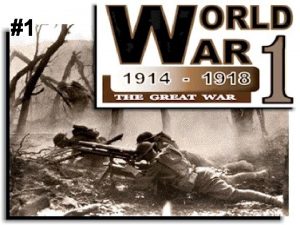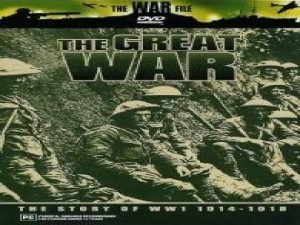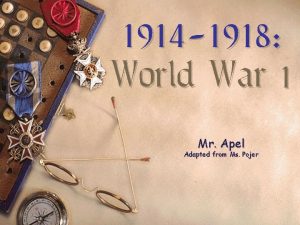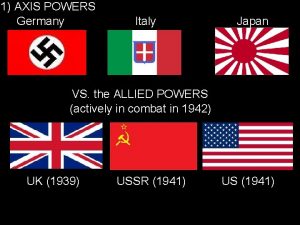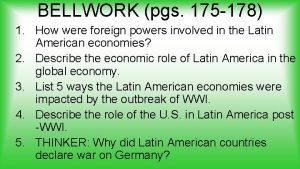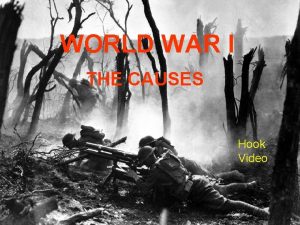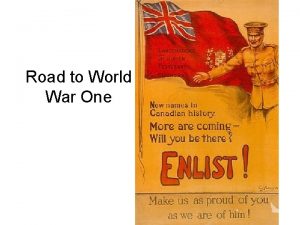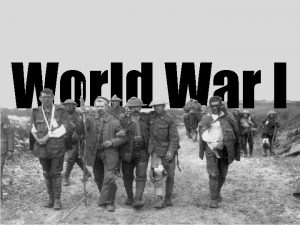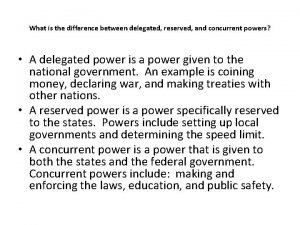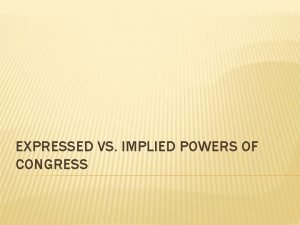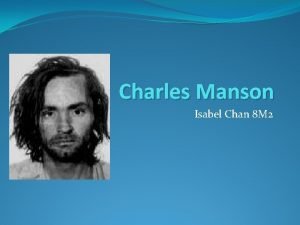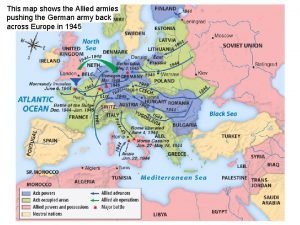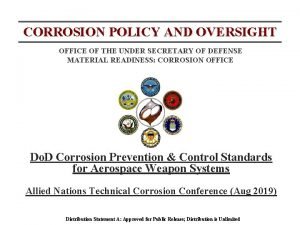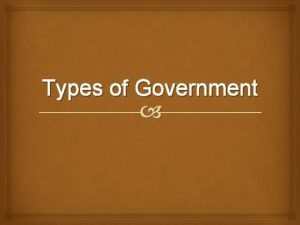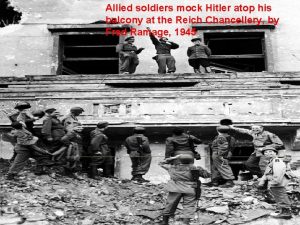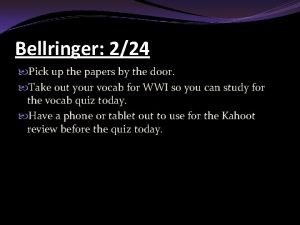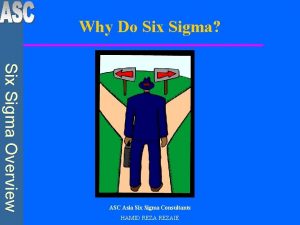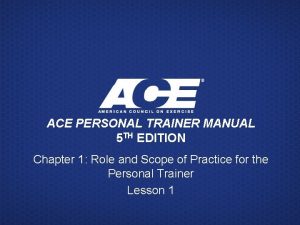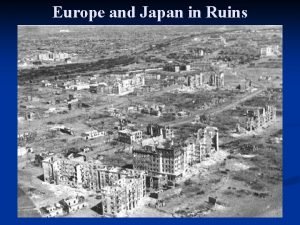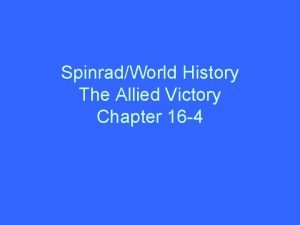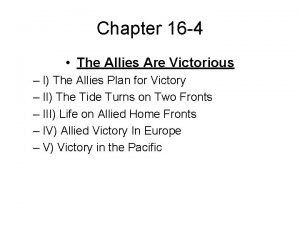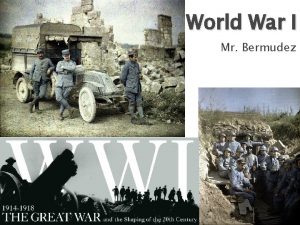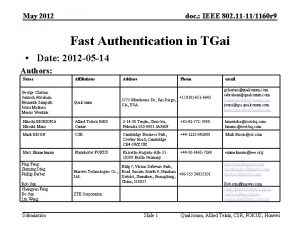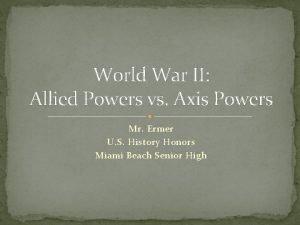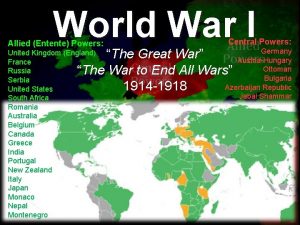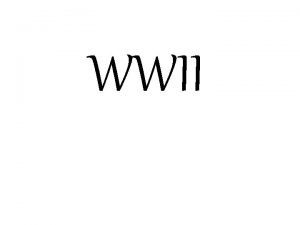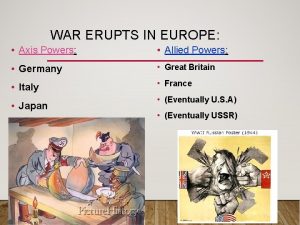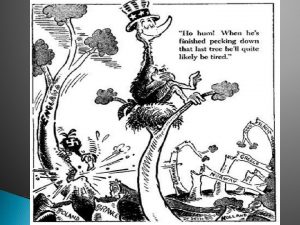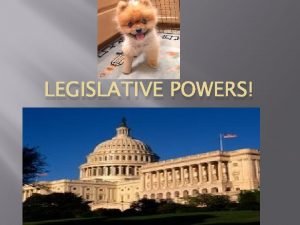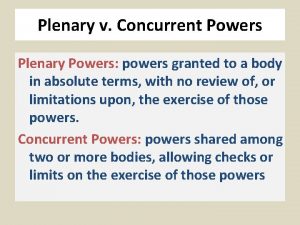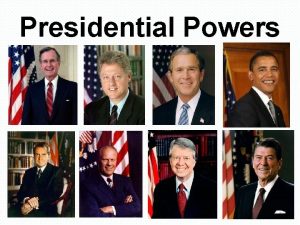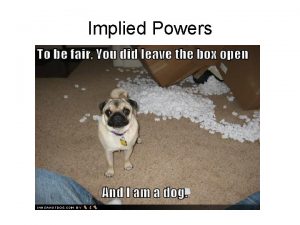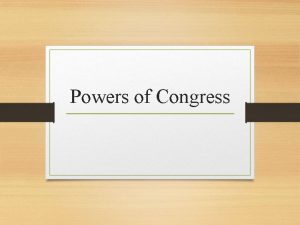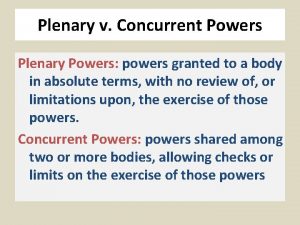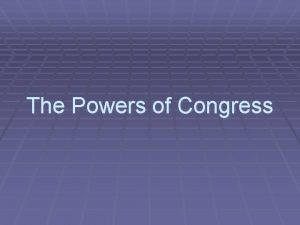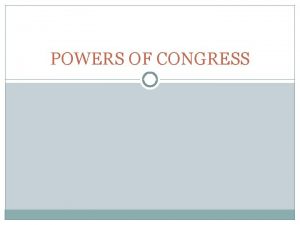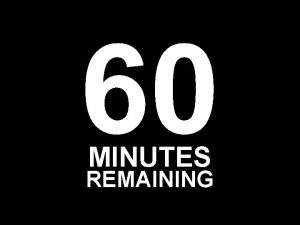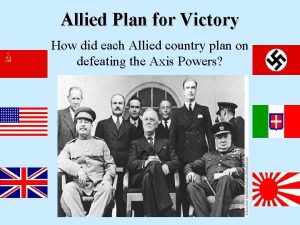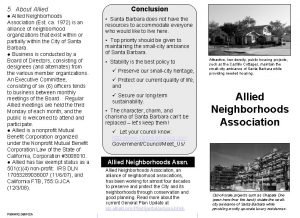7 minutes Allied Powers France n Charles De

























































- Slides: 57

7 minutes

Allied Powers

France n Charles De Gaulle n Led opposition against Germany after they took over France

Allied Powers

Great Britain n Winston Churchill n Great orator and leader who kept British citizens from giving up Churchill

Allied Powers

Soviet Union (Russia) n Joseph Stalin n Great Purge – killed all people who opposed his rule or spoke against Soviet Union Stalin

Allied Powers

FDR and Harry Truman Franklin D. Roosevelt Dies on April 12, 1945 FDR Vice President assumes role of President. Sees the country through he last few months of war – makes decision on the atomic bomb

Axis Powers

Italy n Benito Mussolini n Promised a new Roman Empire Bully Mussolini

Axis Powers

Japan Emperor Hirohito n Wanted full political and economic control of Pacific n Believed in militarism and military run Hirohito society n

Japan n Prime Minister Hideki Tojo q Responsible for all military operations during the war Tojo

Axis Powers

Germany n Adolph Hitler n Leader of Nazi political party n Blamed Jews for all of Germany’s economic problems n Since 1933, built up troops in Rhineland. Hitler

September 1, 1939 n Germany invades Poland after being warned not to invade by France and Great Britain n Official start of World War II

Start of WW II in Europe Polish city of Wieluń just after German bombing, 1 st of September n In August 1939 Germany 1939 and the Soviet Union signed a nonaggression pact. n In September 1939 Germany invaded Poland n France and Britain (Poland’s allies) declared war on Germany. n The Nazis succeeded in a “blitzkrieg” of Poland quickly continued to move west.

Early Battles of WW German n Next, France fell to the Nazis II troops in 1940. enter Paris n Throughout 1940 -41, Germany June 14, attacked Britain with bombing 1940 raids, but the Royal Air Force withstood the attacks, and Hitler never invaded Britain.

U. S. “NEUTRALITY” n 1. 2. 3. Many ISOLATIONISTS in the U. S. opposed getting involved in Europe because WWI had caused financial debt Many believed that the manufacturers only wanted war to profit economically Death from WWI was still fresh in people’s memories

U. S. “NEUTRALITY” n The U. S. declared official neutrality, however, after Poland fell, Congress allowed “cash-and-carry”: The U. S. would sell arms to the Allies if they paid in cash and carried the goods away on their own ships + =

U. S. “NEUTRALITY” n. After France fell, FDR transferred 50 WWI destroyers to Britain in return for the use of bases in Newfoundland the Caribbean. “Destroyers for bases”

U. S. “NEUTRALITY” n While Britain suffered from the Nazi air raids night and day in 1940, Congress passed the first peacetime draft in U. S. History n After FDR was re-elected to a third term, he urged Congress to provide more direct aid to the Allied nations.

U. S. “NEUTRALITY” n. Congress passed the Lend Lease Act in 1941, which provided the Allies with weapons and supplies on credit. n. FDR said it was like “lending a garden-hose to a nextdoor neighbor whose house was on fire. ”

U. S. “NEUTRALITY” • • To make sure the Allied countries received the supplies, the U. S. Navy protected American merchant ships, and eventually, merchant ships were armed. By the fall of 1941, ships were instructed to “shoot on sight” any German submarine

Japanese aggression n. In 1937 Japan invaded China and Manchuria n. WHY? RESOURCES! n. The U. S. placed an embargo on oil & steel to Japan.

Japanese aggression n. Japan and the U. S. attempted to negotiate, but Japan refused to withdraw from China. n. Japan attacked the naval base at Pearl Harbor on December 7, 1941

Japanese aggression infamy • FDR said this was “a date that FDR will live in infamy. ” signing the • The attack on Pearldeclaration Harbor caused the U. S. to declare war of war with on Japan on December 8, 1941 Japan • Soon, Germany and Italy declared war on the U. S.

U. S. preparation for war n. Government rationed some products.

U. S. preparation for war n. War bonds & income taxes funded the war.

U. S. preparation for war n. Factories made war-time products.

U. S. preparation for war n. Selective service (draft) put more men in the army.

Building Morale n. Government censored the media. n. Ad campaigns and patriotic movies and newsreels kept up public morale. Newsreel

Minorities in WWII n. African-Americans fought in segregated units, like the Tuskegee Airmen. Tuskeegee

Minorities in WWII n. Japanese-Americans fought in segregated Nisei Regiments. Nisei

Minorities in WWII n. Mexican-Americans fought in integrated units.

Minorities in WWII Code Talkers n. Native American Navajo Code-Talkers tricked the Japanese. n. HOW? n The Japanese could not figure out the messages because Navajo is a language, not a code.

n. Minorities had many casualties & won many medals. n. African-Americans and women moved to northern cities to work in factories.

Minorities in WWII Rosie the Riveter

War Strategies--AXIS n In 1941, Germany turned against the U. S. S. R. , who had been an ally before. n Germany hoped to use blitzkrieg (lightning war) to defeat the U. S. S. R. & Britain before the U. S. could get organized.

War Strategies--AXIS n. Japan hoped to conquer so much land that the U. S. would be scared to fight.

War Strategies--ALLIES “defeat Hitler first” before dealing with Japan Defeat him first! n. When the U. S. entered the war this was the deal FDR made with Churchill n

War Strategies--ALLIES n. In the Pacific, the U. S. went “island hopping, ” nconquering one small island after another on the way to Japan.

First Major Allied In North Africa, the Victory Germans wanted n Middle Eastern oil and control of the Suez Canal. n The British defeated them at El Alamein in 1942. El Alamein

Turning Points n. The Allies invaded Normandy on the French coast n. D-Day, Normandy June 6, 1944. n. Allies pushed west through France until they reached Germany in 1945. D-Day

Turning Points n Soviets defeated Germans at Stalingrad after a long siege July 17, 1942 -January 31, 1943. n The Germans were forced to Stalingrad retreat west from the USSR, and they were being pushed east out of the Mediterranean at the same time by the Allies.

Turning Points n. Midway was the first U. S. defeat of Japan in the Midway Pacific in 1942. n. This battle started the “island-hopping” campaign.

Turning Points n. The U. S. won bloody battles for Iwo Jima & Okinawa in Okinawa 1945 as they Iwoapproached Jima the Japanese mainland. n. Many Japanese pilots committed suicide by kamikaze attacks during these battles.

End of WWII n. Hitler shot himself, and Germany surrendered. n. V-E Day: May 8, 1945

End of WWII n. U. S. dropped two atomic bombs over Hiroshima and Nagasaki in Japan on Aug. 6 and 9. n. V-J Day: Aug. 15, 1945

Results of the War

Japanese Internment n Out of fear that Japanese in America were spies they were sent to camps. n In 1942 FDR issued Executive Order 9066 which ordered the internment of over 110, 000 Japanese-Americans Internment

Japanese Internment n. Many lost property & money and faced prejudice. n. The Supreme Court upheld the internment in Korematsu v. U. S. n. The U. S. has since apologized and provided compensation

n. The Geneva Convention set the standards for international law for humanitarian concerns.

n. Bataan Death March killed many U. S. POWs in the Philippines as their Japanese captors moved them from one camp to another

n. Hitler’s n. Targeted Final Solution Jews, Gypsies, Genocide: Poles, Slavs, and “undesirables” (mentally ill, systematic killing of homosexuals, and political adissidents). particular group n About 12 million were killed. of people Path to Genocide

n. Nuremberg Trials Nazi leaders were convicted of war crimes. n. This increased the desire for a Jewish homeland, Israel, which was established in 1948.
 Allied and central powers
Allied and central powers Was the united states on the axis powers or allied powers?
Was the united states on the axis powers or allied powers? Triple alliance
Triple alliance Big 3 allied powers
Big 3 allied powers Who are allied powers
Who are allied powers 1
1 Allied powers
Allied powers Allied forces
Allied forces Triple entente
Triple entente Allied powers ww1
Allied powers ww1 Allied powers
Allied powers Who are allied powers
Who are allied powers 1 minute or minutes
1 minute or minutes Delegated powers vs reserved powers
Delegated powers vs reserved powers Informal checks on the president
Informal checks on the president Implied vs expressed powers
Implied vs expressed powers Expressed vs enumerated powers
Expressed vs enumerated powers Implied vs enumerated powers
Implied vs enumerated powers Charles luther manson
Charles luther manson Allied educator moe
Allied educator moe Allied bank remittance
Allied bank remittance List of all allied health professions
List of all allied health professions The map shows that allied forces
The map shows that allied forces Mil-std-889c
Mil-std-889c The allied health profession service improvement project
The allied health profession service improvement project Autocracy
Autocracy Mark twain
Mark twain Who were the four major allied countries?
Who were the four major allied countries? Justin dibb allied gold
Justin dibb allied gold Sigma levels
Sigma levels Www svcfin com bill pay
Www svcfin com bill pay Ahs contract
Ahs contract Ace code of ethics
Ace code of ethics Note 3 ways war affected the land
Note 3 ways war affected the land What are the allied fields of physical education
What are the allied fields of physical education Allied healthcare continuum
Allied healthcare continuum National general core value plan
National general core value plan Allied young
Allied young Economic importance of slime molds
Economic importance of slime molds The allied victory chapter 16 section 4
The allied victory chapter 16 section 4 Ouhsc sonography
Ouhsc sonography Which medal of honor recipient is described
Which medal of honor recipient is described Ty richmond allied universal
Ty richmond allied universal Chapter 16 section 4 the allied victory
Chapter 16 section 4 the allied victory Allied healthcare continuum
Allied healthcare continuum Allied health recovery request example
Allied health recovery request example Allied health professionals
Allied health professionals Allied areas
Allied areas 2019 dod allied nations technical corrosion conference
2019 dod allied nations technical corrosion conference Allied winch
Allied winch Allied flow controls
Allied flow controls Types of angles grade 8
Types of angles grade 8 Who started world war 1
Who started world war 1 Allied telsis
Allied telsis The allied health profession service improvement project
The allied health profession service improvement project Was japan an allied power in ww2
Was japan an allied power in ww2 Cumulative index to nursing and allied health
Cumulative index to nursing and allied health What is waste
What is waste
